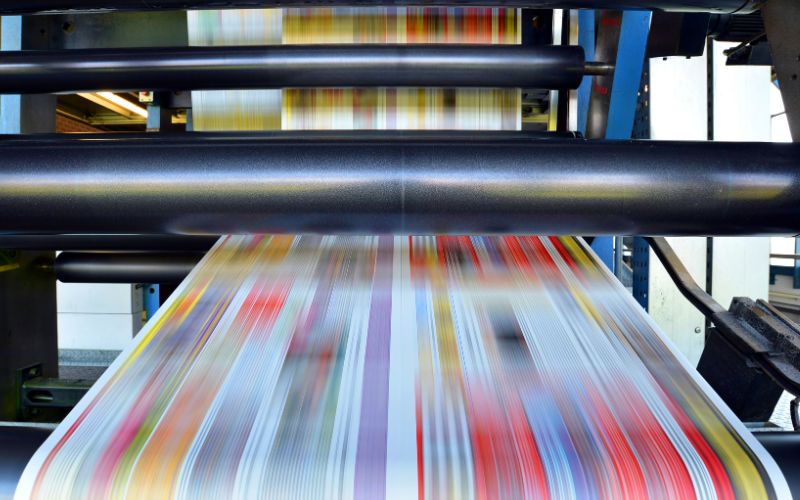The world of advertising can be a labyrinth for the uninitiated. The sheer variety of ad types—each with unique advantages, disadvantages, and ideal use cases—makes choosing the right one for your campaign daunting. But fear not! An understanding of different ad types can be the compass that helps you navigate the labyrinth.
In this blog post, we’ll deconstruct the ads world, offering a toolkit that equips advertisers with the knowledge to make informed decisions. You will journey through traditional and digital advertising landscapes, exploring emerging formats, and learn how to select the best ad type for your campaigns. We’ll also highlight the expertise of Clean Marketing, renowned for its innovative pressure-washing ad campaigns. Ready to start this exciting journey? Buckle up!
The Power of the Printed Word: Print Ads

Print advertisements, one of the oldest forms of advertising, still hold a potent place in the marketer’s toolkit. These appear in newspapers, magazines, brochures, and more, blending visually appealing designs with compelling copy.
Critical features of print ads include:
1. Tangibility: You can touch and feel them, creating a unique sensory experience.
2. Longevity: Unlike digital ads that can disappear in a flash, print ads last as long as the printed material does.
3. Detailed Information: Print ads often offer space for in-depth information about a product or service.
Advantages of print ads:
* Targeted: Can be tailored or targeted for specific audiences based on the publication’s demographic.
* High Engagement: Readers spend more time on print ads, potentially leading to higher engagement.
Disadvantages of print ads:
* High Cost: Printing and distribution can be expensive.
* Limited Reach: Print ads generally have a local or regional reach, not global.
The Drama of the Small Screen: TV Commercials

TV commercials are short advertising spots that run during TV show breaks. They use storytelling, celebrity endorsements, and creative visuals to grab viewers’ attention and create a lasting impression.
Characteristics of TV Commercials:
1. Emotional Appeal: Utilize sound, visuals, and storytelling to create a solid emotional connection.
2. Wide Reach: Can reach millions of viewers simultaneously.
3. High Production Value: Usually professionally produced and high quality.
Advantages of TV Commercials:
* Large Audience: Broadcast to national or even international audiences.
* Multisensory Experience: Engages visual and auditory senses for a more memorable impact.
Disadvantages of TV Commercials:
* Expensive: High production and airing costs.
* Non-Targeted: Often challenging to target a specific audience demographic.
The Voice of the Airwaves: Radio Ads

Radio ads are audio advertisements broadcast on radio stations. They rely on voiceovers, sound effects, and music to convey their message and grab the listener’s attention.
An excellent case study is a radio ad campaign by a local car dealership, which significantly increased its sales through a catchy jingle and persuasive copy.
Advantages of Radio Ads:
* Targeted: Can target specific audiences based on the radio station’s listenership.
* Cost-Effective: Cheaper to produce and air than TV commercials.
Disadvantages of Radio Ads:
* Limited Engagement: They may only be as engaging with visual elements.
* Fleeting: If a listener misses the ad, they cannot rewind to hear it again.
Clicks, Keywords, and Likes: Digital Advertising
Digital advertising harnesses the power of the internet, offering unique advantages like precise targeting, real-time optimization, and rich data analytics. We’ll explore three dominant forms: display ads, search engine ads, and social media ads.
Display Ads: Billboards of the Digital Highway
Display ads are the banners, sidebar ads, or pop-ups you see on websites. They often incorporate rich media to attract users’ attention, such as images, videos, or interactive elements.
Advantages of Display Ads:
* Highly Visual: Can include vibrant images or interactive designs to draw attention.
* Targeted: Can be programmed to appear on specific websites to specific demographics.
Disadvantages of Display Ads:
* Ad Blockers: Many users install ad blockers, which prevent display ads from appearing.
* Banner Blindness: Users often ignore display ads due to overexposure.
Search Engine Ads: Answering the User’s Query
Search engine ads appear in search engine results when users search for particular keywords. These ads are highly targeted and typically text-based, appearing at the top of the search results page.
Advantages of Search Engine Ads:
* High Intent: Reach users who are actively searching for related keywords.
* Cost-Effective: Pay only when a user clicks on the ad (pay-per-click).
Disadvantages of Search Engine Ads:
* Competitive: Many businesses may compete for popular keywords, driving up costs.
* Requires Expertise: Crafting effective search engine ads requires understanding keyword research, bid management, and ad copywriting.
Social Media Ads: Engaging the Connected Consumer
Social media ads appear on platforms like Facebook, Instagram, Twitter, and LinkedIn and are designed to blend seamlessly into the user’s social feed. They can be targeted based on detailed demographic information, interests, and behavior.
Advantages of Social Media Ads:
* Highly Targeted: Reach a specific demographic using detailed targeting options.
* Variety of Formats: Can use images, videos, carousels, or interactive elements.
Disadvantages of Social Media Ads:
* Can Be Ignored: Users may scroll past social media ads without noticing them.
* Requires Continuous Optimization: Social media ad campaigns require monitoring and adjustment to maintain effectiveness.
The New Kids on the Ad Block: Emerging Advertising Formats
The digital world is constantly evolving, bringing us new ad formats. We’ll explore native advertising, influencer marketing, and video ads.
Native Advertising: The Camouflaged Ad
Native ads are designed to mimic the look, feel, and function of the media format in which they appear. This could mean a promoted article on a news website or a sponsored post in a social media feed.
Advantages of Native Advertising:
* Non-Disruptive: Blends with the user experience instead of interrupting it.
* Higher Engagement: Users may engage more with native ads as they don’t look like traditional ads.
Disadvantages of Native Advertising:
* Could Be Deceptive: If not clearly labeled, users may feel deceived when they realize the content is an ad.
* May Damage Trust: If users feel tricked, it can harm the reputation of the advertiser and the publisher.
Influencer Marketing: Leveraging Online Authority
Influencer marketing involves partnering with influencers—individuals with a substantial online following and a strong influence over their audience—to promote your product or service.
Advantages of Influencer Marketing:
* Trust: Influencers have built trust with their audience, and their recommendation can carry weight.
* Targeted: If chosen wisely, influencers can help you reach a niche, engaged audience.
Disadvantages of Influencer Marketing:
* Unpredictable: Influencers can sometimes become involved in controversies, which could negatively impact your brand.
* Hard to Measure: It can take time to track the direct impact of influencer marketing on sales.
Video Ads: The Motion Picture Billboard
Video ads come in many formats, including pre-roll (before a video), mid-roll (during a video), or post-roll (after a video). They are engaging, memorable, and can convey complex information in a short time.
Advantages of Video Ads:
* Engaging: People engage more with video content than text or images.
* Information-Rich: Can communicate more information and evoke emotions more effectively.
Disadvantages of Video Ads:
* Expensive: High-quality video production can be costly.
* Intrusive: If not used correctly, video ads can be seen as disruptive and annoying.
The Right Ad for Your Message: Choosing the Right Ad Type for Your Campaign

The secret sauce to a successful ad campaign is selecting the right ad type that aligns with your objectives, target audience, and budget. Factors to consider include:
* Audience: Who are you trying to reach? What are their preferences and habits?
* Objectives: What is your campaign goal? Brand awareness, lead generation, or sales?
* Budget: Different ad types have different costs associated with them.
Once you’ve chosen an ad type, remember to test and optimize for the best results continuously. This could involve A/B testing different creatives, tweaking your targeting, or adjusting your bid strategy.
Conclusion: The End is Just the Beginning
This journey through the world of ads—from print to video ads—has shed light on the various ad types available for advertisers. Therefore, it’s crucial to stay updated with evolving ad formats and not hesitate to experiment to find the most effective ad type for your specific goals.
Your advertising efforts can be the difference between business obscurity and a thriving enterprise. Companies like Clean Marketing, with their unique and effective pressure washing ads, offer excellent examples of how innovative advertising can propel a business forward. If you’re looking for experts to help with advertising your pressure washing business, visit Clean Marketing’s website and see how they can assist you in creating an impactful advertising campaign.
Remember, understanding ads is a continual learning process, but with the right toolkit and mindset, you can master the art and science of advertising. Happy advertising!







